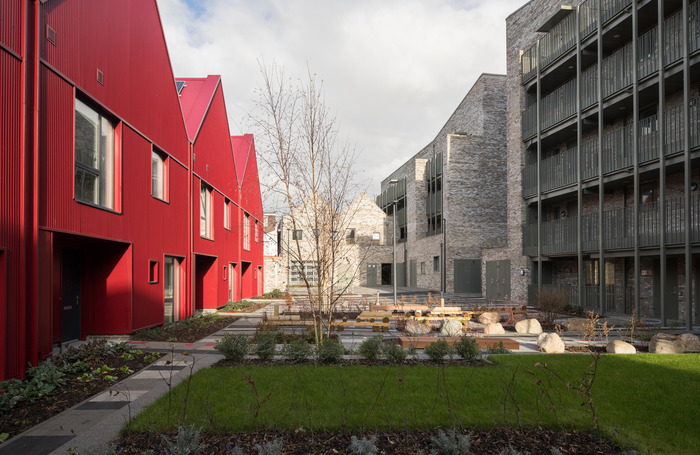The revised National Planning Policy Framework (NPPF) has been published with a new emphasis on the delivery of new homes, and for the design community to put design quality at the heart of the system.
RIBA Planning Group members have picked out what they consider to be the most significant changes to the old framework and the consultation document published earlier this year.

Stephen Gleave, Director of Gleave 23, endorses the statements that declare high quality buildings and places to be fundamental to planning and development. But the question remains: will they make a difference? Previous planning guidance made similar calls.
‘We have to be positive. At the outset of our national policy framework, design quality is fundamental to what must be achieved from planning activity. Advisers have a duty, we suggest, to highlight this with all clients, public and private. This is a shared responsibility. The NPPF must be read as a whole – there are threads throughout that put expectations of design quality across the system,’ says Gleave.
‘Where there is disagreement in negotiation, planners will know they have support in the NPPF to hold ground and not see design quality undermined.’
In her briefing to HTA on key statements on housing, HTA Planning Partner Riette Oosthuizen picks out changes to viability assessments, a widened definition of ‘affordable housing’, and a mixed picture with regard to targets for the delivery of housing on small sites – the revised document doubles the size of what is classed as a ‘small site’ in the draft document to one hectare.
Crucially, Oosthuizen points out, the revised NPPF gives planning decision makers the power to decide how much weight to give to viability assessments, which should allow local authorities to resist developments coming forward with limited affordable housing. Planning guidance now clearly reinforces court rulings that have established that the price paid for land cannot be used to justify a failure to meet local plan policies.
Oosthuizen points to the Housing Delivery Test rulebook, published alongside the new NPPF, as a key document that shifts the emphasis from local housing targets to actual delivery. The test compares what has been built with past forecasts, and where targets have been repeatedly missed, a variety of sanctions can be applied against the local authority.
Several Planning Group members zeroed in on Paragraph 130 as a statement that directly addresses a real problem of build quality and has the potential to produce tangible results:
Local planning authorities should also seek to ensure that the quality of approved development is not materially diminished between permission and completion, as a result of changes being made to the permitted scheme (for example through changes to approved details such as the materials used.
At issue, of course, is the 50% of UK construction output delivered by design and build and the many projects where the original architect is not retained beyond the planning stage, where no-one is liable for ensuring the quality of what gets built.
This is a real issue, says Planning Group chair Philip Waddy: ‘Unlike Building Control where a Completion Certificate is issued, there is no similar certification of compliance with the planning consent. In my experience, once permission is granted and conditions discharged, the local planning authority seldom monitors what actually happens on site.’
Gleave adds that the test of what constitutes a ‘materially diminished’ change will be determined through challenge, but he sees Paragraph 130 as taking its place in a framework that now promotes best practice at all stages of construction.
‘When materials are specified and approved, builders will always be chasing the market for best price. Theirs is a commercial enterprise. The planning system must hold ground in maintaining the standards set in the approval. This was the developer’s commitment and risk,’ argues Gleave.
Rural planning specialists meanwhile have seized on an expanded section on ‘Supporting a Prosperous Rural Economy’. New Paragraph 84 states that sites to meet local business and community needs in rural areas may have to be found adjacent to or beyond existing settlements, and in locations that are not well served by public transport.
Richard Wooldridge, Director of Harrison Pitt Architects, sees this as a loosening of control over location, and a revision that will be of definite use to architects who practice away from major urban centres.
Ruth Reed, Past President and former chair of the Planning Group, finds other subtle changes in the new NPPF that will support additional development in the countryside, such as the call for policies that identify opportunities for villages to ‘grow and thrive’ (Paragraph 87), a more proactive statement than the ‘enhance and maintain’ found in the previous framework.
Thanks to Stephen Gleave, Director, Gleave 23 Ltd; Riette Oosthuizen, Planning Partner, HTA Architects; Philip Waddy, Partner, West Waddy ADP; Richard Wooldridge, Director, Harrison Pitt Architects; Ruth Reed, Director, Green Planning Studio Ltd.
Text by Neal Morris. This is a Professional Feature edited by the RIBA Practice team. Send us your feedback and ideas
RIBA Core Curriculum Topic: Places, planning and communities.
As part of the flexible RIBA CPD programme, Professional Features count as microlearning. See further information on the updated RIBA CPD Core Curriculum and on fulfilling your CPD requirements as an RIBA Chartered Member.
Posted on 2 August 2018.









